Abstract
Hypoxia in isolated myocytes results in accumulation of long-chain acylcarnitines (LCA) in sarcolemma. Inhibition of carnitine acyltransferase I (CAT-I) with sodium 2-[5-(4-chlorophenyl)-pentyl]-oxirane-2-carboxylate (POCA) prevents both the accumulation of LCA in the sarcolemma and the initial electrophysiologic derangements associated with hypoxia. Another amphiphilic metabolite, lysophosphatidylcholine (LPC), accumulates in the ischemic heart in vivo, in part because of inhibition of its catabolism by accumulating LCA. It induces electrophysiologic alterations in vitro analogous to early changes induced by ischemia in vivo. The present study was performed to determine whether POCA could prevent accumulation of both LCA and LPC induced by ischemia in vivo and if so, whether attenuation of early arrhythmogenesis would result. LAD coronary artery occlusions were induced for 5 min in chloralose-anesthetized cats. Coronary occlusion in untreated control animals elicited prompt, threefold increases of LCA (73 +/- 8 to 286 +/- 60 pmol/mg protein) and twofold increase of LPC (3.3 +/- 0.4 to 7.5 +/- 0.9 nmol/mg protein) selectively in the ischemic zone, associated with ventricular tachycardia (VT) or ventricular fibrillation (VF) occurring within the 5-min interval before acquisition of myocardial samples in 64% of the animals. POCA prevented the increase of both LCA and LPC. It also prevented the early occurrence of VT or VF (within 5 min of occlusion) in all animals studied. The antiarrhythmic effect of POCA was not attributable to favorable hemodynamic changes or to changes in myocardial perfusion measured with radiolabeled microspheres. Thus, inhibition of CAT-I effectively reduced the incidence of lethal arrhythmias induced early after the onset of ischemia. Accordingly, pharmacologic inhibition of this enzyme provides a promising approach for prophylaxis of sudden cardiac death, that typically occurs very soon after the onset of acute ischemia, in man.
Full text
PDF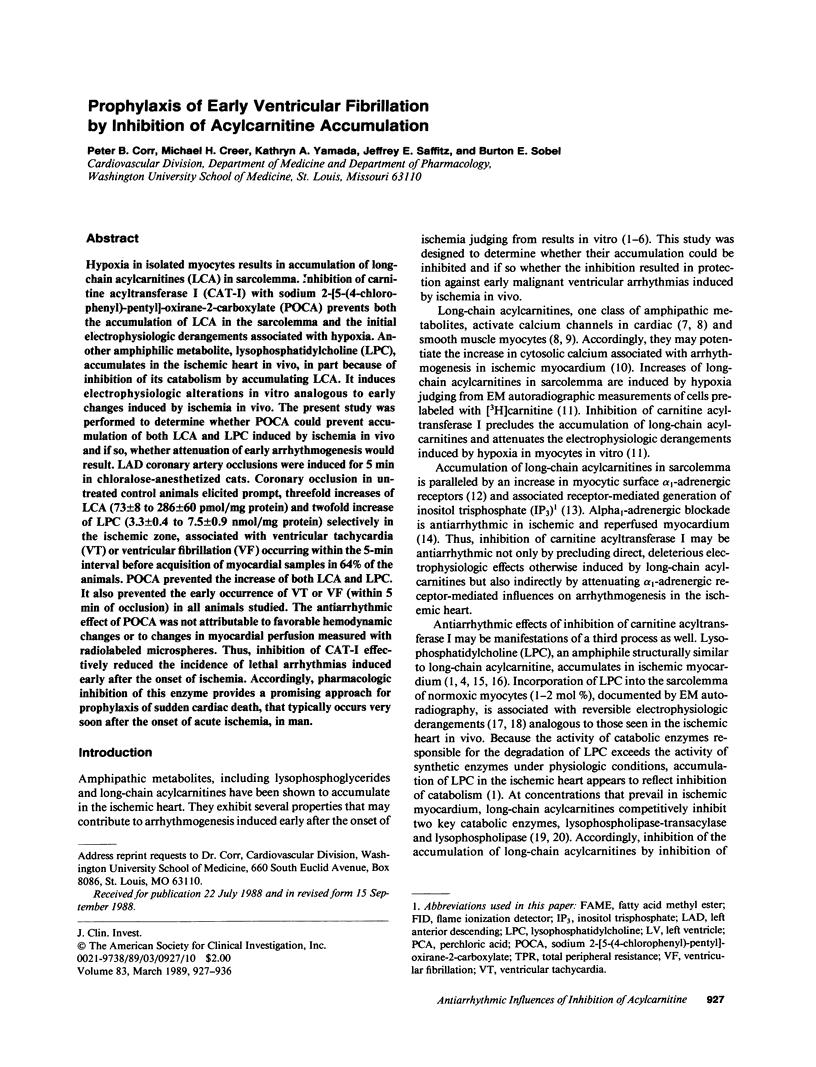
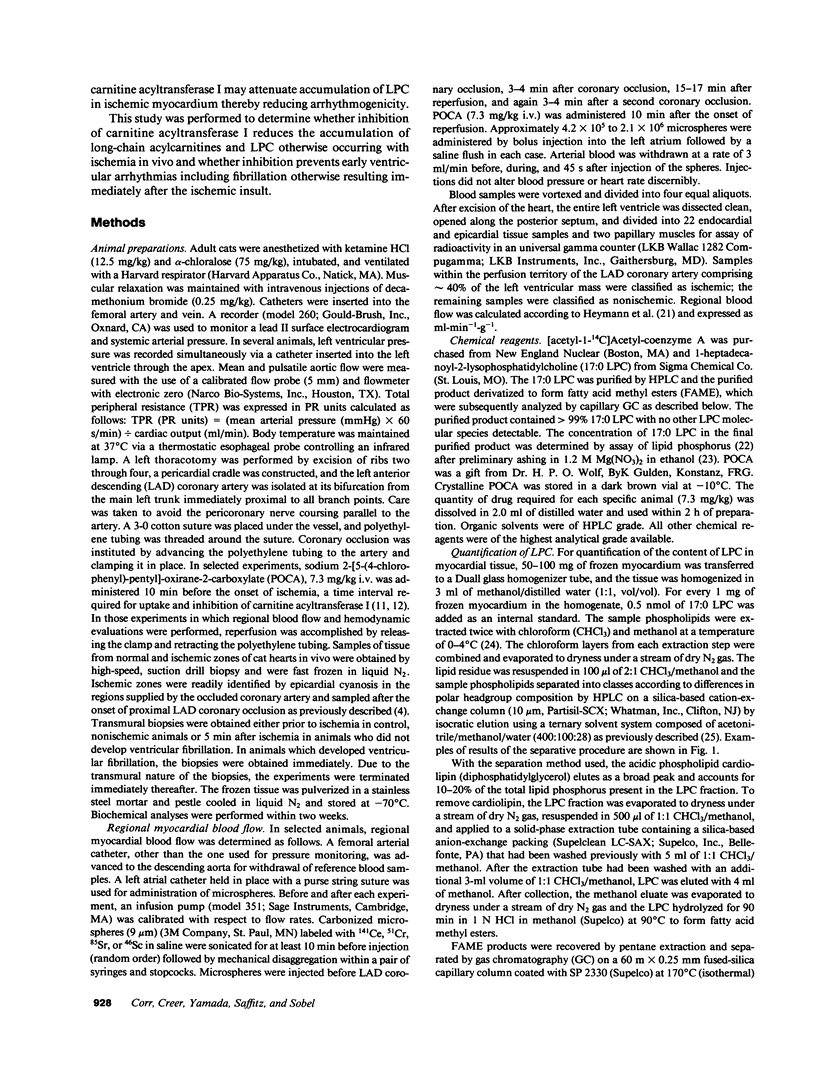
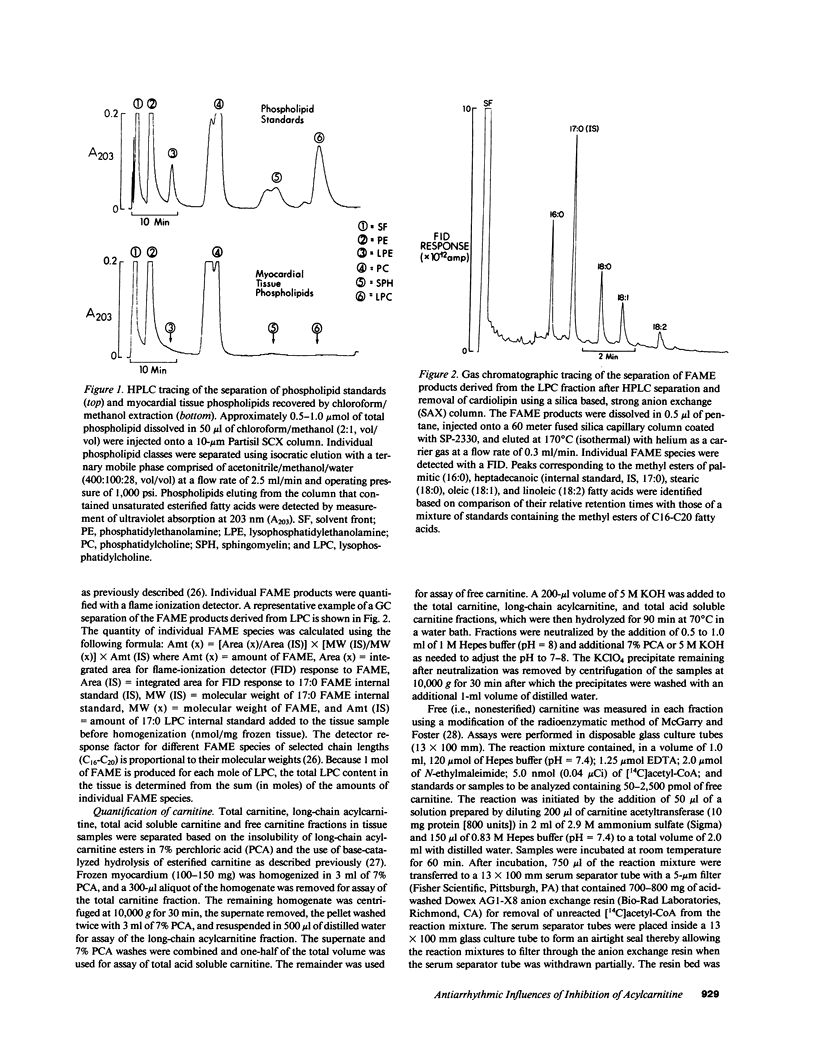
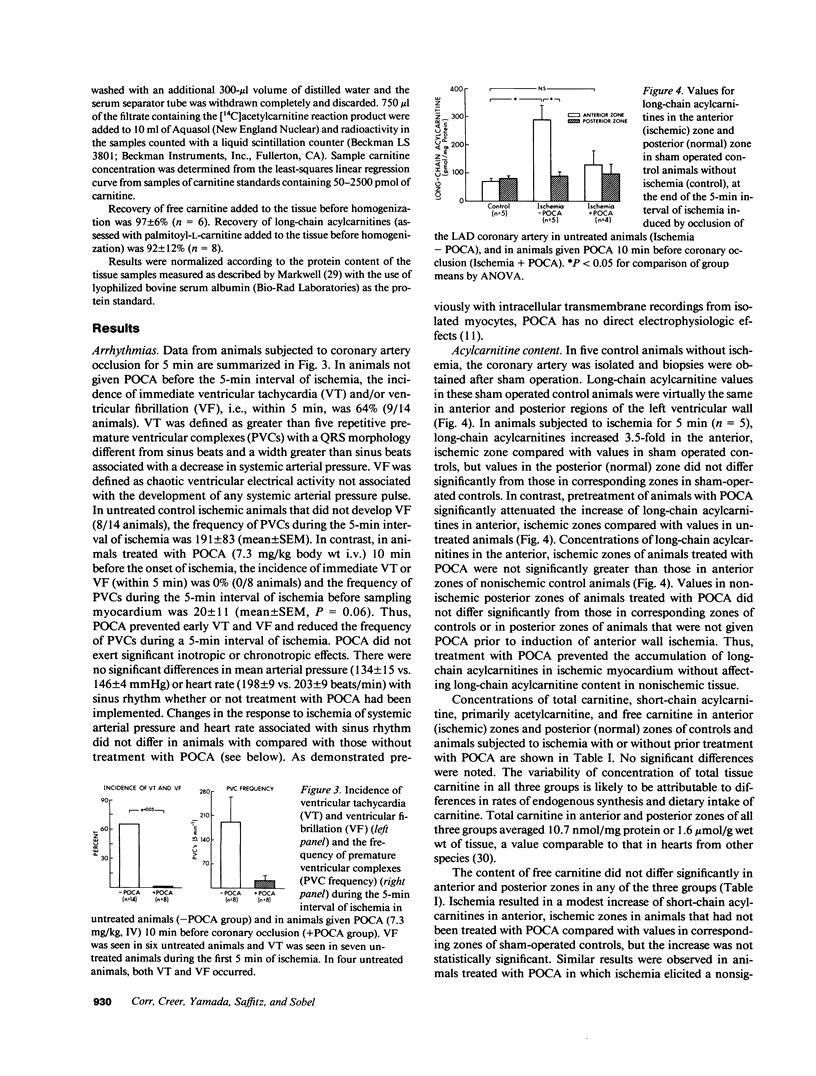
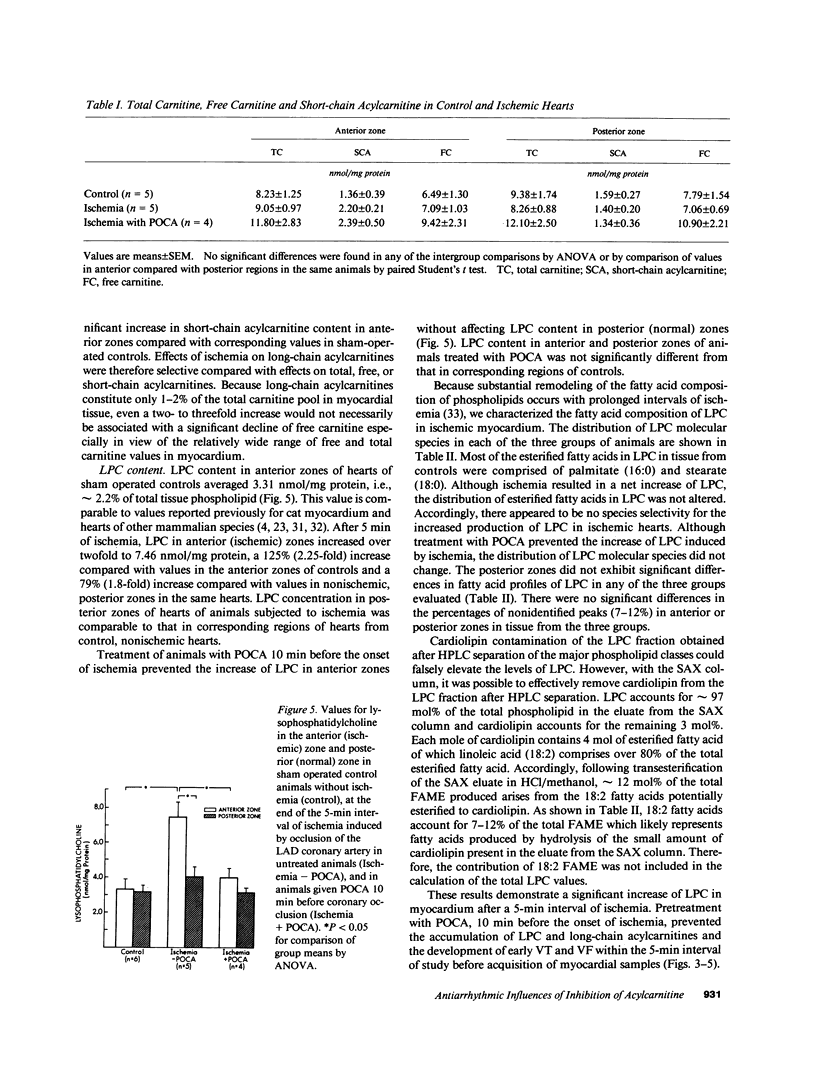
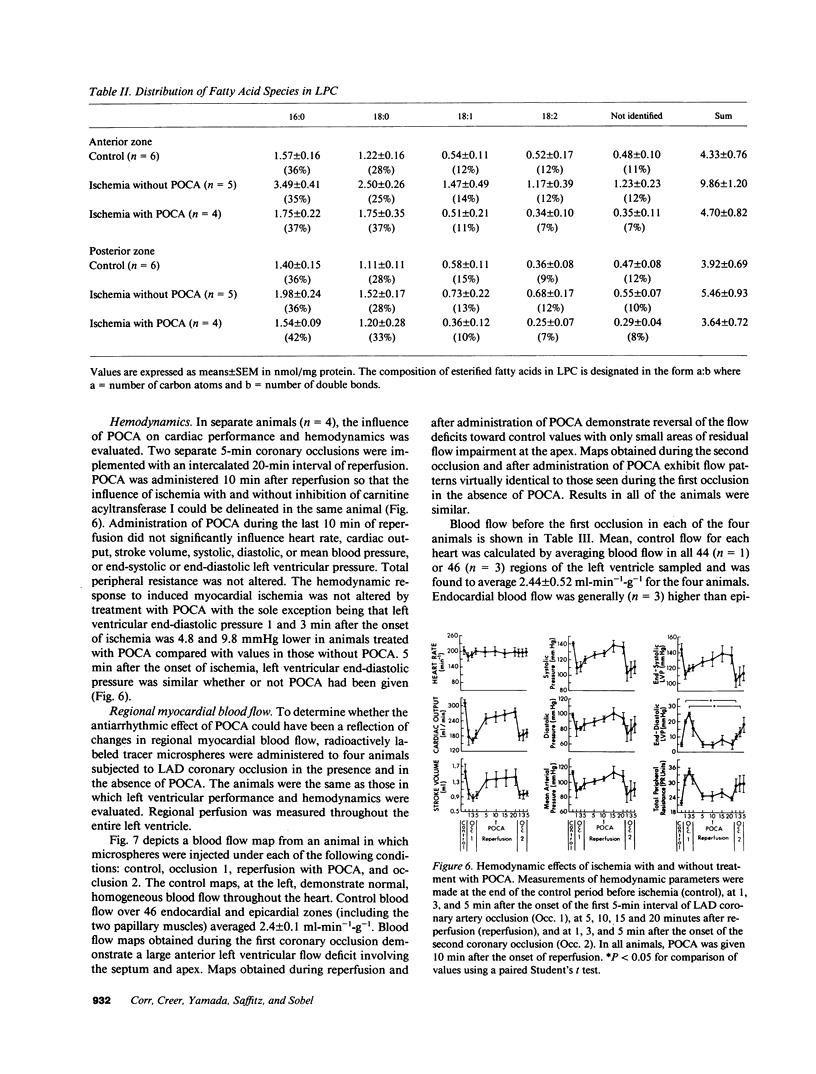
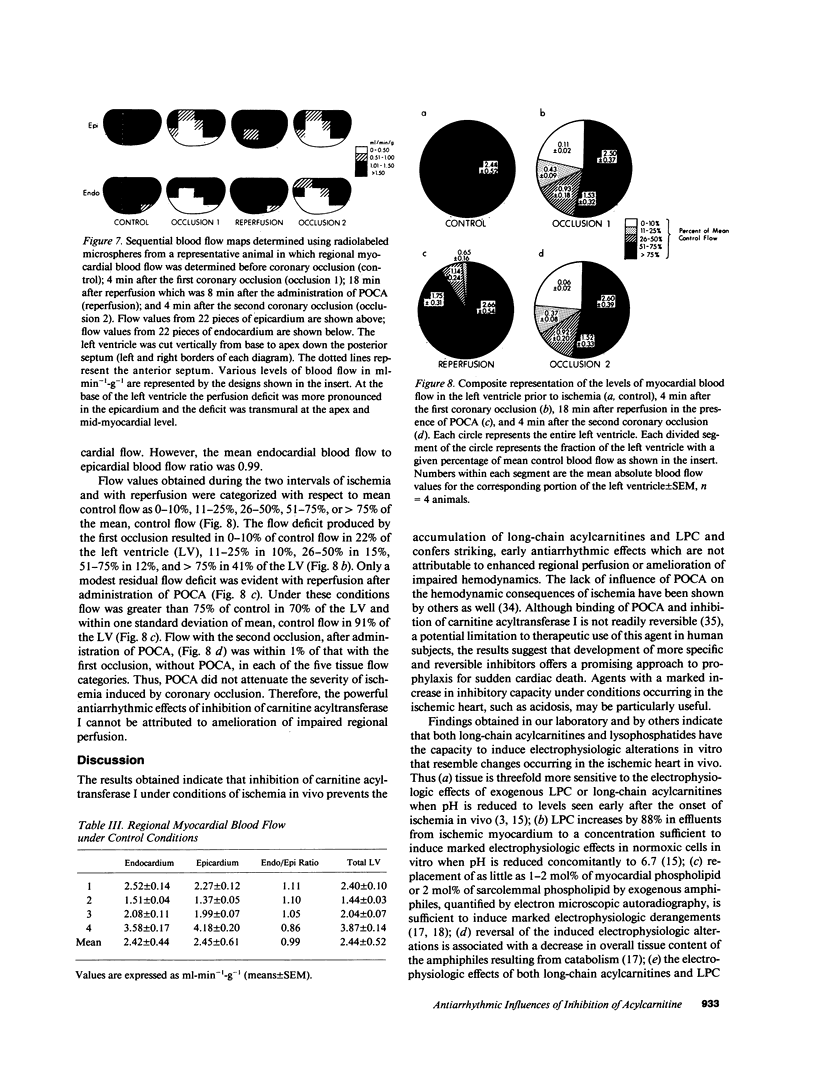
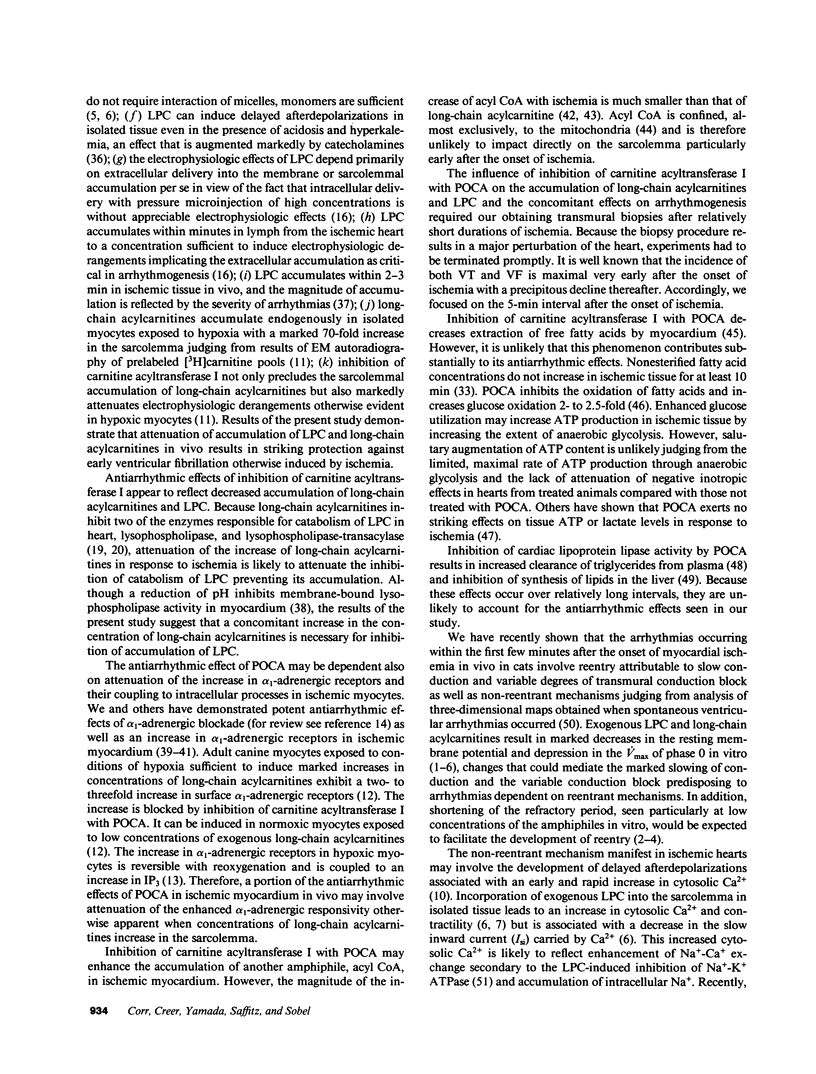
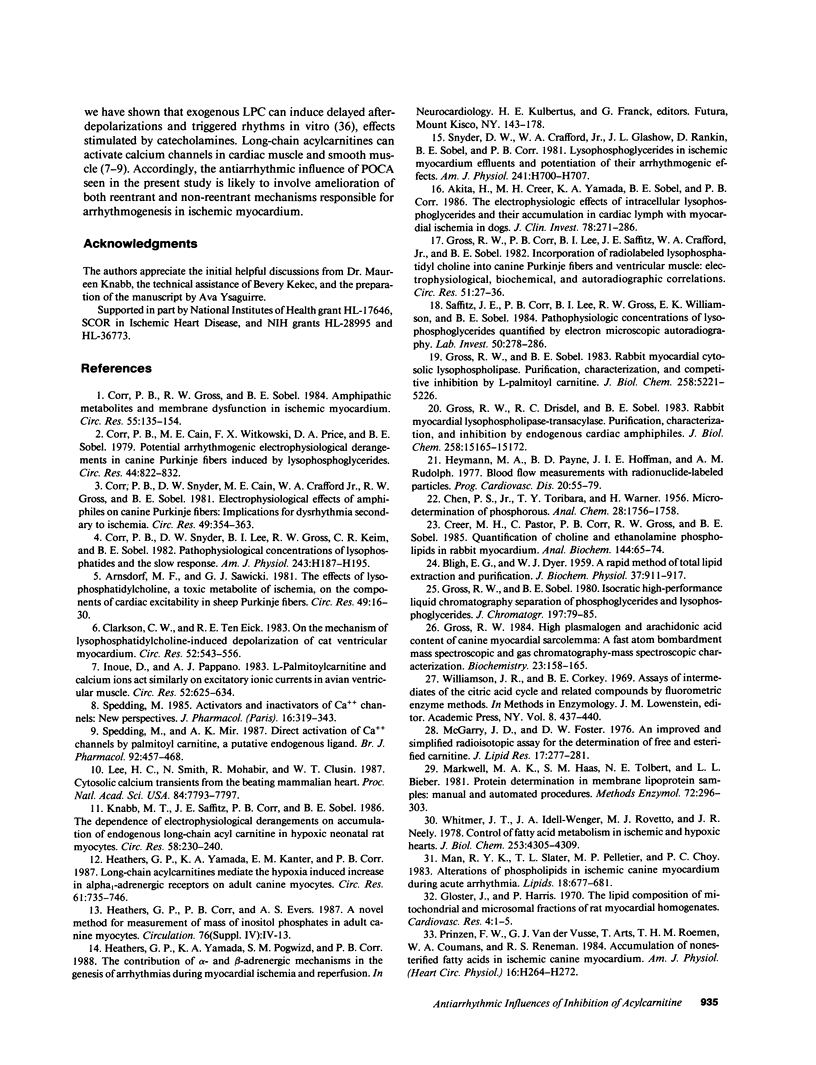
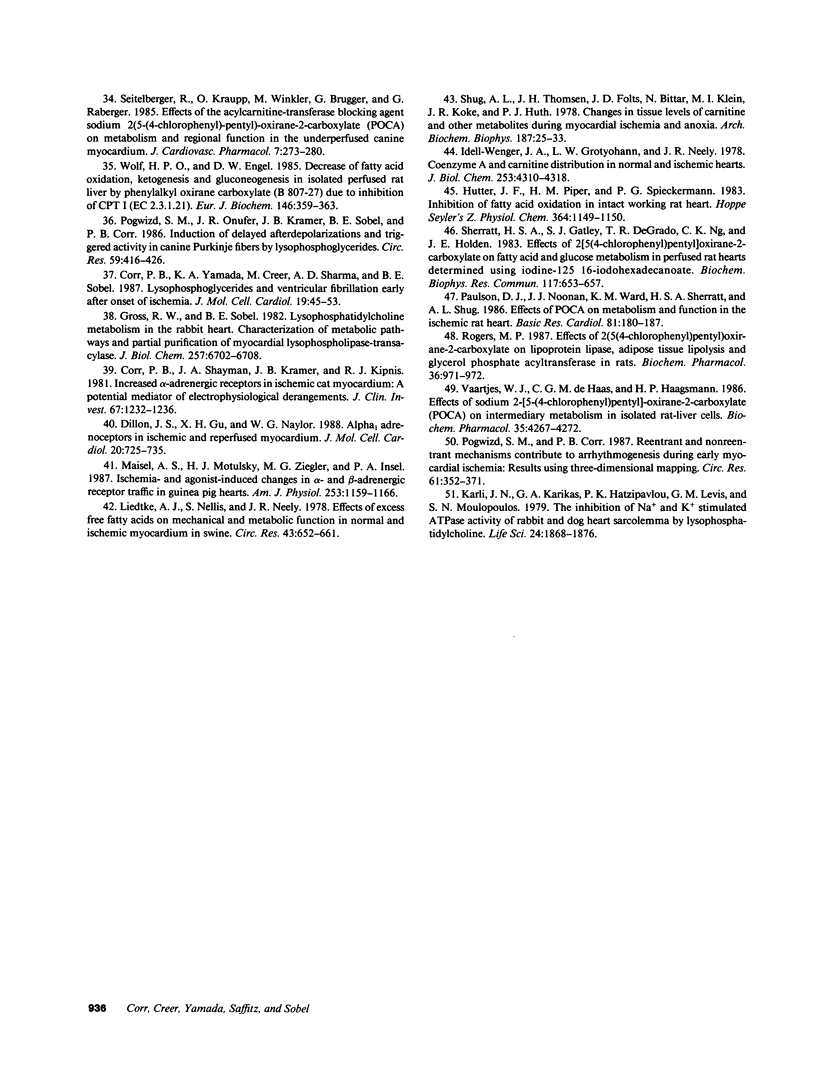
Selected References
These references are in PubMed. This may not be the complete list of references from this article.
- Akita H., Creer M. H., Yamada K. A., Sobel B. E., Corr P. B. Electrophysiologic effects of intracellular lysophosphoglycerides and their accumulation in cardiac lymph with myocardial ischemia in dogs. J Clin Invest. 1986 Jul;78(1):271–280. doi: 10.1172/JCI112561. [DOI] [PMC free article] [PubMed] [Google Scholar]
- Arnsdorf M. F., Sawicki G. J. The effects of lysophosphatidylcholine, a toxic metabolite of ischemia, on the components of cardiac excitability in sheep Purkinje fibers. Circ Res. 1981 Jul;49(1):16–30. doi: 10.1161/01.res.49.1.16. [DOI] [PubMed] [Google Scholar]
- BLIGH E. G., DYER W. J. A rapid method of total lipid extraction and purification. Can J Biochem Physiol. 1959 Aug;37(8):911–917. doi: 10.1139/o59-099. [DOI] [PubMed] [Google Scholar]
- Clarkson C. W., Ten Eick R. E. On the mechanism of lysophosphatidylcholine-induced depolarization of cat ventricular myocardium. Circ Res. 1983 May;52(5):543–556. doi: 10.1161/01.res.52.5.543. [DOI] [PubMed] [Google Scholar]
- Corr P. B., Cain M. E., Witkowski F. X., Price D. A., Sobel B. E. Potential arrhythmogenic electrophysiological derangements in canine Purkinje fibers induced by lysophosphoglycerides. Circ Res. 1979 Jun;44(6):822–832. doi: 10.1161/01.res.44.6.822. [DOI] [PubMed] [Google Scholar]
- Corr P. B., Gross R. W., Sobel B. E. Amphipathic metabolites and membrane dysfunction in ischemic myocardium. Circ Res. 1984 Aug;55(2):135–154. doi: 10.1161/01.res.55.2.135. [DOI] [PubMed] [Google Scholar]
- Corr P. B., Shayman J. A., Kramer J. B., Kipnis R. J. Increased alpha-adrenergic receptors in ischemic cat myocardium. A potential mediator of electrophysiological derangements. J Clin Invest. 1981 Apr;67(4):1232–1236. doi: 10.1172/JCI110139. [DOI] [PMC free article] [PubMed] [Google Scholar]
- Corr P. B., Snyder D. W., Cain M. E., Crafford W. A., Jr, Gross R. W., Sobel B. E. Electrophysiological effects of amphiphiles on canine purkinje fibers. Implications for dysrhythmia secondary to ischemia. Circ Res. 1981 Aug;49(2):354–363. doi: 10.1161/01.res.49.2.354. [DOI] [PubMed] [Google Scholar]
- Corr P. B., Snyder D. W., Lee B. I., Gross R. W., Keim C. R., Sobel B. E. Pathophysiological concentrations of lysophosphatides and the slow response. Am J Physiol. 1982 Aug;243(2):H187–H195. doi: 10.1152/ajpheart.1982.243.2.H187. [DOI] [PubMed] [Google Scholar]
- Corr P. B., Yamada K. A., Creer M. H., Sharma A. D., Sobel B. E. Lysophosphoglycerides and ventricular fibrillation early after onset of ischemia. J Mol Cell Cardiol. 1987 Oct;19 (Suppl 5):45–53. doi: 10.1016/s0022-2828(87)80609-0. [DOI] [PubMed] [Google Scholar]
- Creer M. H., Pastor C., Corr P. B., Gross R. W., Sobel B. E. Quantification of choline and ethanolamine phospholipids in rabbit myocardium. Anal Biochem. 1985 Jan;144(1):65–74. doi: 10.1016/0003-2697(85)90084-3. [DOI] [PubMed] [Google Scholar]
- Dillon J. S., Gu X. H., Nayler W. G. Alpha 1 adrenoceptors in the ischaemic and reperfused myocardium. J Mol Cell Cardiol. 1988 Aug;20(8):725–735. doi: 10.1016/s0022-2828(88)80017-8. [DOI] [PubMed] [Google Scholar]
- Gloster J., Harris P. The lipid composition of mitochondrial and microsomal fractions of rat myocardial homogenates. Cardiovasc Res. 1970 Jan;4(1):1–5. doi: 10.1093/cvr/4.1.1. [DOI] [PubMed] [Google Scholar]
- Gross R. W., Corr P. B., Lee B. I., Saffitz J. E., Crafford W. A., Jr, Sobel B. E. Incorporation of radiolabeled lysophosphatidyl choline into canine Purkinje fibers and ventricular muscle. Electrophysiological, biochemical, and autoradiographic correlations. Circ Res. 1982 Jul;51(1):27–36. doi: 10.1161/01.res.51.1.27. [DOI] [PubMed] [Google Scholar]
- Gross R. W., Drisdel R. C., Sobel B. E. Rabbit myocardial lysophospholipase-transacylase. Purification, characterization, and inhibition by endogenous cardiac amphiphiles. J Biol Chem. 1983 Dec 25;258(24):15165–15172. [PubMed] [Google Scholar]
- Gross R. W. High plasmalogen and arachidonic acid content of canine myocardial sarcolemma: a fast atom bombardment mass spectroscopic and gas chromatography-mass spectroscopic characterization. Biochemistry. 1984 Jan 3;23(1):158–165. doi: 10.1021/bi00296a026. [DOI] [PubMed] [Google Scholar]
- Gross R. W., Sobel B. E. Isocratic high-performance liquid chromatography separation of phosphoglycerides and lysophosphoglycerides. J Chromatogr. 1980 Sep 5;197(1):79–85. doi: 10.1016/s0021-9673(00)80538-5. [DOI] [PubMed] [Google Scholar]
- Gross R. W., Sobel B. E. Lysophosphatidylcholine metabolism in the rabbit heart. Characterization of metabolic pathways and partial purification of myocardial lysophospholipase-transacylase. J Biol Chem. 1982 Jun 25;257(12):6702–6708. [PubMed] [Google Scholar]
- Gross R. W., Sobel B. E. Rabbit myocardial cytosolic lysophospholipase. Purification, characterization, and competitive inhibition by L-palmitoyl carnitine. J Biol Chem. 1983 Apr 25;258(8):5221–5226. [PubMed] [Google Scholar]
- Heathers G. P., Yamada K. A., Kanter E. M., Corr P. B. Long-chain acylcarnitines mediate the hypoxia-induced increase in alpha 1-adrenergic receptors on adult canine myocytes. Circ Res. 1987 Nov;61(5):735–746. doi: 10.1161/01.res.61.5.735. [DOI] [PubMed] [Google Scholar]
- Heymann M. A., Payne B. D., Hoffman J. I., Rudolph A. M. Blood flow measurements with radionuclide-labeled particles. Prog Cardiovasc Dis. 1977 Jul-Aug;20(1):55–79. doi: 10.1016/s0033-0620(77)80005-4. [DOI] [PubMed] [Google Scholar]
- Idell-Wenger J. A., Grotyohann L. W., Neely J. R. Coenzyme A and carnitine distribution in normal and ischemic hearts. J Biol Chem. 1978 Jun 25;253(12):4310–4318. [PubMed] [Google Scholar]
- Inoue D., Pappano A. J. L-palmitylcarnitine and calcium ions act similarly on excitatory ionic currents in avian ventricular muscle. Circ Res. 1983 Jun;52(6):625–634. doi: 10.1161/01.res.52.6.625. [DOI] [PubMed] [Google Scholar]
- Knabb M. T., Saffitz J. E., Corr P. B., Sobel B. E. The dependence of electrophysiological derangements on accumulation of endogenous long-chain acyl carnitine in hypoxic neonatal rat myocytes. Circ Res. 1986 Feb;58(2):230–240. doi: 10.1161/01.res.58.2.230. [DOI] [PubMed] [Google Scholar]
- Lee H. C., Smith N., Mohabir R., Clusin W. T. Cytosolic calcium transients from the beating mammalian heart. Proc Natl Acad Sci U S A. 1987 Nov;84(21):7793–7797. doi: 10.1073/pnas.84.21.7793. [DOI] [PMC free article] [PubMed] [Google Scholar]
- Liedtke A. J., Nellis S., Neely J. R. Effects of excess free fatty acids on mechanical and metabolic function in normal and ischemic myocardium in swine. Circ Res. 1978 Oct;43(4):652–661. doi: 10.1161/01.res.43.4.652. [DOI] [PubMed] [Google Scholar]
- Man R. Y., Slater T. L., Pelletier M. P., Choy P. C. Alterations of phospholipids in ischemic canine myocardium during acute arrhythmia. Lipids. 1983 Oct;18(10):677–681. doi: 10.1007/BF02534533. [DOI] [PubMed] [Google Scholar]
- Markwell M. A., Haas S. M., Tolbert N. E., Bieber L. L. Protein determination in membrane and lipoprotein samples: manual and automated procedures. Methods Enzymol. 1981;72:296–303. doi: 10.1016/s0076-6879(81)72018-4. [DOI] [PubMed] [Google Scholar]
- McGarry J. D., Foster D. W. An improved and simplified radioisotopic assay for the determination of free and esterified carnitine. J Lipid Res. 1976 May;17(3):277–281. [PubMed] [Google Scholar]
- Paulson D. J., Noonan J. J., Ward K. M., Stanley H., Sherratt A., Shug A. L. Effects of POCA on metabolism and function in the ischemic rat heart. Basic Res Cardiol. 1986 Mar-Apr;81(2):180–187. doi: 10.1007/BF01907382. [DOI] [PubMed] [Google Scholar]
- Pogwizd S. M., Corr P. B. Reentrant and nonreentrant mechanisms contribute to arrhythmogenesis during early myocardial ischemia: results using three-dimensional mapping. Circ Res. 1987 Sep;61(3):352–371. doi: 10.1161/01.res.61.3.352. [DOI] [PubMed] [Google Scholar]
- Pogwizd S. M., Onufer J. R., Kramer J. B., Sobel B. E., Corr P. B. Induction of delayed afterdepolarizations and triggered activity in canine Purkinje fibers by lysophosphoglycerides. Circ Res. 1986 Oct;59(4):416–426. doi: 10.1161/01.res.59.4.416. [DOI] [PubMed] [Google Scholar]
- Prinzen F. W., Van der Vusse G. J., Arts T., Roemen T. H., Coumans W. A., Reneman R. S. Accumulation of nonesterified fatty acids in ischemic canine myocardium. Am J Physiol. 1984 Aug;247(2 Pt 2):H264–H272. doi: 10.1152/ajpheart.1984.247.2.H264. [DOI] [PubMed] [Google Scholar]
- Rogers M. P. Effects of 2[5(4-chlorophenyl)pentyl]oxirane-2-carboxylate on lipoprotein lipase, adipose tissue lipolysis and glycerol phosphate acyltransferase in rats. Biochem Pharmacol. 1987 Mar 15;36(6):971–972. doi: 10.1016/0006-2952(87)90193-6. [DOI] [PubMed] [Google Scholar]
- Saffitz J. E., Corr P. B., Lee B. I., Gross R. W., Williamson E. K., Sobel B. E. Pathophysiologic concentrations of lysophosphoglycerides quantified by electron microscopic autoradiography. Lab Invest. 1984 Mar;50(3):278–286. [PubMed] [Google Scholar]
- Seitelberger R., Kraupp O., Winkler M., Brugger G., Raberger G. Effects of the acylcarnitine-transferase blocking agent sodium 2[5-(4-chlorophenyl)-pentyl]-oxirane-2-carboxylate (POCA) on metabolism and regional function in the underperfused canine myocardium. J Cardiovasc Pharmacol. 1985 Mar-Apr;7(2):273–280. doi: 10.1097/00005344-198503000-00011. [DOI] [PubMed] [Google Scholar]
- Sherratt H. S., Gatley S. J., DeGrado T. R., Ng C. K., Holden J. E. Effects of 2[5(4-chlorophenyl)pentyl]oxirane-2-carboxylate on fatty acid and glucose metabolism in perfused rat hearts determined using iodine-125 16-iodohexadecanoate. Biochem Biophys Res Commun. 1983 Dec 28;117(3):653–657. doi: 10.1016/0006-291x(83)91646-7. [DOI] [PubMed] [Google Scholar]
- Shug A. L., Thomsen J. H., Folts J. D., Bittar N., Klein M. I., Koke J. R., Huth P. J. Changes in tissue levels of carnitine and other metabolites during myocardial ischemia and anoxia. Arch Biochem Biophys. 1978 Apr 15;187(1):25–33. doi: 10.1016/0003-9861(78)90003-6. [DOI] [PubMed] [Google Scholar]
- Snyder D. W., Crafford W. A., Jr, Glashow J. L., Rankin D., Sobel B. E., Corr P. B. Lysophosphoglycerides in ischemic myocardium effluents and potentiation of their arrhythmogenic effects. Am J Physiol. 1981 Nov;241(5):H700–H707. doi: 10.1152/ajpheart.1981.241.5.H700. [DOI] [PubMed] [Google Scholar]
- Spedding M. Activators and inactivators of Ca++ channels: new perspectives. J Pharmacol. 1985 Oct-Dec;16(4):319–343. [PubMed] [Google Scholar]
- Spedding M., Mir A. K. Direct activation of Ca2+ channels by palmitoyl carnitine, a putative endogenous ligand. Br J Pharmacol. 1987 Oct;92(2):457–468. doi: 10.1111/j.1476-5381.1987.tb11343.x. [DOI] [PMC free article] [PubMed] [Google Scholar]
- Vaartjes W. J., De Haas C. G., Haagsman H. P. Effects of sodium 2-[5-(4-chlorophenyl)pentyl]-oxirane-2-carboxylate (POCA) on intermediary metabolism in isolated rat-liver cells. Biochem Pharmacol. 1986 Dec 1;35(23):4267–4272. doi: 10.1016/0006-2952(86)90705-7. [DOI] [PubMed] [Google Scholar]
- Whitmer J. T., Idell-Wenger J. A., Rovetto M. J., Neely J. R. Control of fatty acid metabolism in ischemic and hypoxic hearts. J Biol Chem. 1978 Jun 25;253(12):4305–4309. [PubMed] [Google Scholar]
- Wolf H. P., Engel D. W. Decrease of fatty acid oxidation, ketogenesis and gluconeogenesis in isolated perfused rat liver by phenylalkyl oxirane carboxylate (B 807-27) due to inhibition of CPT I (EC 2.3.1.21). Eur J Biochem. 1985 Jan 15;146(2):359–363. doi: 10.1111/j.1432-1033.1985.tb08661.x. [DOI] [PubMed] [Google Scholar]


